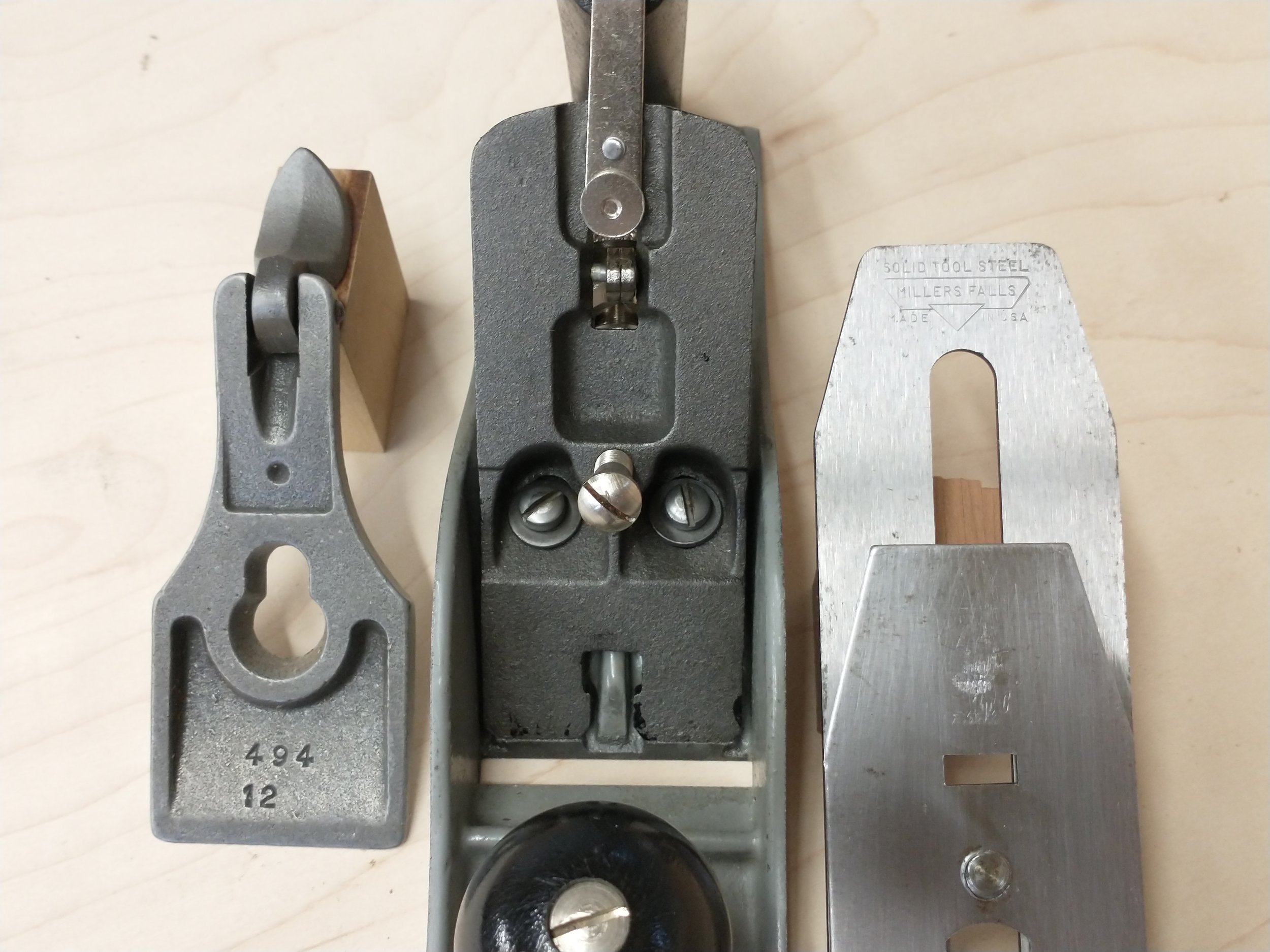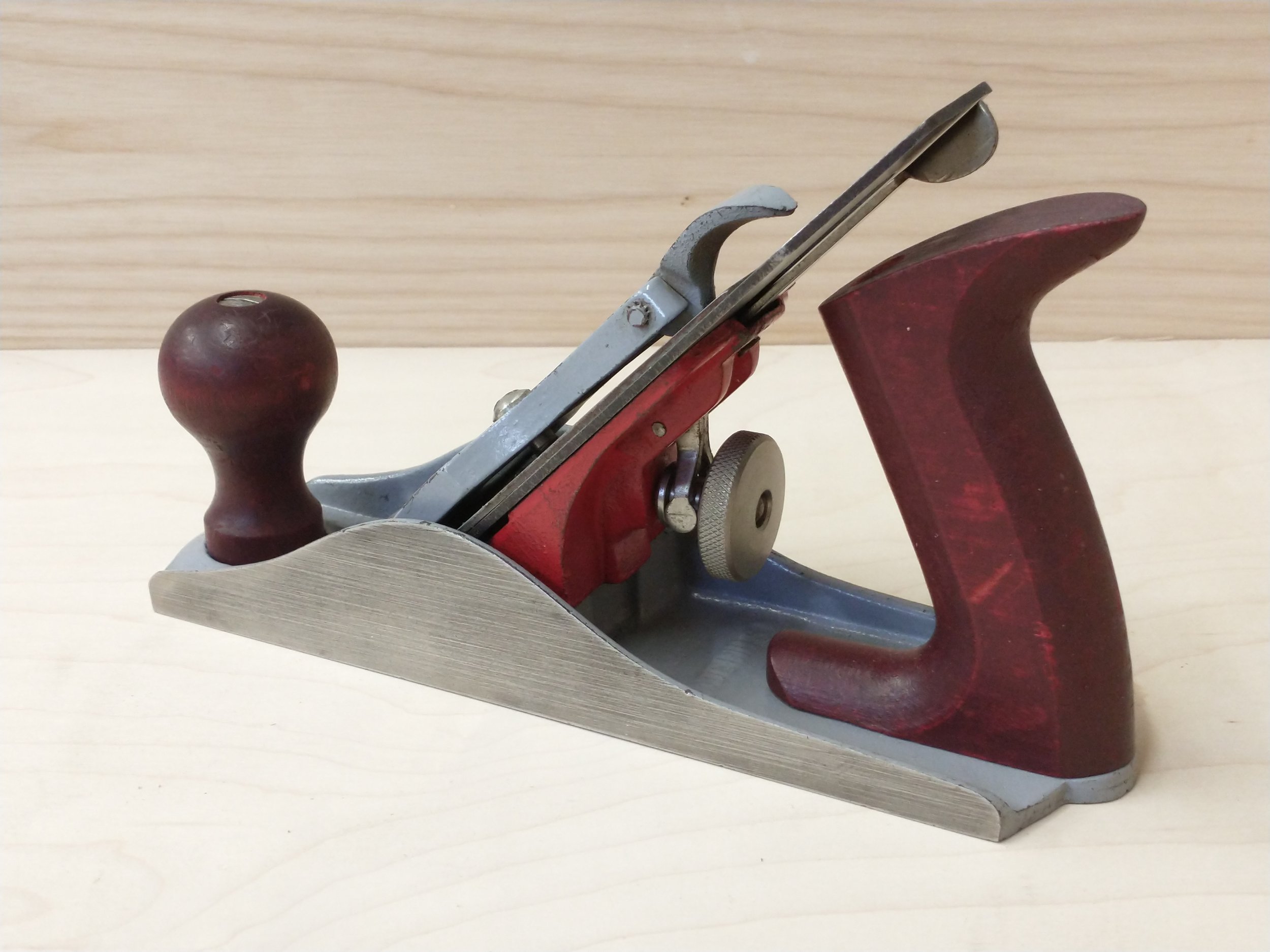
No. 900 and No. 814
Jump to
No. 900/814
The No. 900 and No. 814 production line ran from 1931 to 1974. The No. 900 is a smoothing plane with a 9-3/8 inch sole and is the same size as the premium No. 9 plane. The 14 inch sole on the No. 814 is the same size as the No. 14 jack plane. The No. 900/814 line was introduced as a reliable plane at a lower price point than the premium line. This was done by eliminating the frog adjustment, using a one piece lever cap, and using birch hardwood for the knob and tote with a black lacquer finish.
The No. 900/814 followed or led with many of the same changes as the premium line, but used a different manufacturing process to give it a unique type study. During the time in production, there were eighteen distinct changes in the style of these models. Most of these style changes involved a change in paint only.
Because there were so many changes during the production cycle, I am going to break this list into four types:
Mohawk Shelburne are type 1 (1931 – 1944)
Post MS with recessed depth adjusting nut and a cam lever spring are type 2 (1944 – 1953
Solid depth adjusting nut with no cam lever springs are type 3 (1953 – 1964?)
The ‘B’ version will be type 4. (1964? – 1974)
There will be different styles or versions in each type, so I will add a letter designation to help keep track of the order that I think they were produced. The order in this document is my opinion and is not the proven order of production. If multiple examples of a style have been found, a “V” will be added to the last column to indicate the style has been Verified. A “1” in that column shows only one example for that style has been found.
|
Type |
Body-Color |
Frog-Color |
Cap-Color |
Iron |
Stamp |
V |
|---|---|---|---|---|---|---|
| 1A | Black | 317-Black | 397-Black | MS-No USA | Name-Iron | V |
| 1B | Black | 317-Black | 397-Black | MS-No USA | Name-Iron | 1 |
| 1C | Black | 317-Black | 397-Red/Blk | MS | Name-Iron | V |
| 1D | Black | 317-Black | 397-Red/Blk | MS | Name-Iron | V |
| 1E | Black | 317-Black | 397-Red/Blk | MS | Name-Iron | V |
| 1F | Black | 317-Black | 397-Black | MS | Name-Iron | V |
| 1G | Black | 317-Black | 397-Black | MS | Name-Iron | V |
| 1H | Black | 317-Red | 397-Black | MS | Name-Iron | V |
| 2A | Black | 496A-Red | 397-Black | MF | Name-Iron | V |
| 2B | Black | 496A-Red | 942-Black | STS | N&N Cheek | V |
| 2C | Black | 496A-Black | 942-Black | STS | N&N Cheek | V |
| 2D | Black | 496A-Black | 942-Black | STS | N&N Tote | V |
| 3A | Gray | 496A-Black | 494-Gray | STS | N&N Tote | V |
| 3B | Gray | 496A-Red | 494-Gray | STS | N&N Tote | V |
| 3C | Gray | 496A-Red | 494-Gray | STS | No N&N | V |
| 3D | Gray | 496-Red | 494-Gray | STS | Name-Tote | V |
| 3E | Gray | 496-Red | 494-Gray | STS | N&N Cheek/Tote | V |
| 4A | Gray | 496-Red | 494-Gray | STS | N&N Cheek/Tote | V |
| 4B | Gray | 496-Red | 494-Gray | No Stamp | N&N Cheek | V |
Mohawk Shelburne Type 1 Planes 1931 to 1944
The Mohawk Shelburne line started in 1931 when Millers Falls combined their Mohawk line with the newly acquired Goodell Pratt’s Shelburne line producing a line of tools for the occasional user. During the Mohawk Shelburne years there were as many as seven different style and hardware changes to the plane. There is no clear date when the Mohawk line ended but in 1944 Millers Falls dropped six block planes and one bench plane from the production line. Millers Falls needed a secondary line so I believe the name was changed at this time.
Type 1A
The first release (Type 1A) used many of the features as the type 1 premium planes without the cast name and number and a frog adjustment.
Going through the features on this release,
Body - black bed, casting number - 302(900), 305(814)
Body - high support rib.
Body - the bottom of the heel tab was even with the sole.
Body - “MADE IN U.S.A. was cast in the bed behind the upper frog seat and the tote.
Body - no identifying name and number either cast or stamped on the cheek.
Body - no frog adjuster screw.
Frog - black paint, 317 casting number - 2”
Frog - cast iron yoke.
Frog - a recessed nickel depth adjusting nut.
Frog - folded lateral adjustment lever.
Frog - no frog adjuster tab.
Frog - no yoke pin recess and no frog face relief.
Frog - 12-20 flat fillister head frog locking screws.
Lever Cap - black one piece with a cam lever spring, 397 casting number.
Knob and tote are birch hardwood with a black lacquer finish.
Knob/Tote - Type 1 style secured with a brass waist nut on a 12-20 double threaded rod.
Iron - “MOHAWK SHELBURNE” stamped on the top of the iron.
I will outline the features found on these planes going through the different versions.

On the first release, only the name is stamped on the iron. "MADE IN USA" will be added on version 1C.

Many of the same features found on the type 1 premium line are on this plane.

Cast iron yoke with no yoke pin recess.

The heel tab is flush with the sole. The rebrand planes (Fulton, Craftsman) will have this same configuration. On the type 1 premium line, the heel tab is raised off the sole.

Type 1 style. Millers Falls produced two different sized knob and totes. The smaller knob and tote used on the finishing No. 900 are on the left. The larger No. 814 knob and tote are on the right.

The initial release of the type 1 style knob did not incorporate the eight groves on the bottom of the knob. The enlarged hole on the bottom removed the cutting machine marks that secured the knob.
Type 1B
This next version (Type 1B) has the same features in the body, cap, hardware, and iron but the frog has a steel yoke with the yoke pin recess.
2B - No bed knob ribs, high support rib, no frog face relief.
This is an example of an 814 Mohawk Shelburne type 1B plane. The features on this plane are the same as the type 1A except the cast iron yoke in the previous version is now a steel yoke. Also, the frog now has the yoke pin recess on either side of the yoke pin. Earlier versions with a cast iron yoke do not have the yoke pin recess.
Note the back of the bed. You can see the bed has an area that has been milled below the bed surface. This is the area where the premium line would have embossed the “No. 14”. You can see this same milling on the No. 900 type 1B where the premium bed embossed the “No. 9”.
Type 1C
Next is a version (Type 1C) that is identical to the (Type 1B) version with all the same features but has a red and black cap. The cap is an early version because it has a large rivet head attaching the cam spring.
Mohawk Shelburne Type 1 C
Applied black material
On the bevel side of the Mohawk Shelburne irons is a dark almost black applied material. I am not sure what this is or why it was only used on the MS irons. Over the years I have seen irons with a small amount of this black coating remaining on the back of the iron, but in most examples the material has been completely removed from the iron. The iron above is my best example of what the back of the iron should look like.
Type 1D
The next version of the Mohawk Shelburne line has the red and black cap and for the first time the bed under the knob has the bed ribs.
1D - bed knob ribs, high support rib, no frog face relief, round pan head or fillister head locking screws.
Made In USA is between Mohawk Shelburne. The last style had USA under Shelburne.
The premium line introduced the ribs around the 1935-time frame, but I think the Mohawk line was using the rib bed at least a year before the premium line used it. Behind the knob, the body still has the high support rib found on the first release and the frog is the same as the previous version. The iron has ‘MADE IN USA’ now between Mohawk and Shelburne.
Type 1E
This next version changed the lateral adjuster from a folded end to a solid riveted disk. The front support rib was much shorter and there is a relief on the frog face next to the frog locking screws. The 1938 #42 catalog has the lever cap as red/black.
From the image above, this version has the solid disk lateral adjustment lever, and the frog face relief on either side of the frog locking screws.
On the 814 model, the casting gates can be seen for the first time on this version.
Type 1F
In the late 30’s or early 40’s, this next version switched to an all black lever cap. This would be the last version of the 900/814 series to have brass waist nuts to secure the tote and knob..
This Mohawk Shelburne version has the bed knob ribs, low support rib, casting gates and no name and number stamp other than the iron trademark. The frog has a disk lateral adjustment lever, frog face relief , steel yoke and the yoke pin recess. Based on these features, this version was in production for a short time before MF switched to the single bolt securing the knob and tote.
Type 1G
This is the version that shows the Mohawk Shelburne line moving into the World War II years.
The use of brass was cut back in the early forties. The only brass used on the No. 900/814 were the waist nuts used to secure the knob and tote. Like the premium line, a one piece steel bolt would now secure the knob and tote.
Millers Falls kept the paint on the cap to all black and changed the knob and tote to except the singe bolt like those found on the premium line at the start of 1942. Unlike the premium line, the wood on the knob and tote did not have to change.
Around 1944, Millers Falls changed the casting number on the 2 in. frog from 317 to 496A. To date, all the examples of a Mohawk Shelburne planes with a single bolt for the knob and tote have a 317 casting number on the frog. More examples are needed to see if the Mohawk version went into the 496A years or did this casting change mark the end of the Mohawk Shelburne brand?
Type 1H
The next Mohawk Shelburne plane is identical to (Type 1G) but this version has a red frog. I am putting this MS plane as (Type 1H) but there is no clear way to know the order of the WWII Mohawk planes.
From 1942 to 1948, Millers Falls used the one piece bolt to secure the knob and tote to their planes. The smaller knob and tote on the left was on the No. 900 smoothing plane. The pair on the right were on the 814. You will find the one piece bolts on the type 1G, 1H and the 2A.
The knob and tote bolts, lever cap screw, frog screws and the depth adjusting nut all seem to be blued.
During WWII, Millers Falls and other manufacturers changed the surface prep on the hardware used on these planes.
The biggest problem with collectors today is that bluing can be removed with improper cleaning. I am sure that the previous version that I have documented here was also blued in the beginning. More examples are needed to see if both versions during the war had the hardware blued.
To date, it is not clear if Millers Falls released this Gold Seal version, or it was a rebrand version for a hardware store. Still looking for that one document what will clear this up.
Gold Seal
The Gold Seal plane was produced between 1935 and 1940. These dates are based on features found on several planes. The earlies plane found had a folded lateral adjustment lever, steel yoke with a yoke pin recess, round head frog locking screws and the frog face without the frog face relief. These features would date the plane around 1935/1936. At the other end of production is a plane with casting gates, brass waist nuts, a lower support rib and a two tone lever cap. Millers Falls stopped painting their Mohawk-Shelburne planes red with the type 1F version. These features date the plane before WWII and after 1938.
900/814 Type 2 planes 1944 to 1952
Around 1944, Millers Falls ended the Mohawk Shelburne line but still needed a line for the homeowner or occasional user. The simplest way to create a new series is to change the trademark stamp on the iron and keep going.
The type 2 planes have a very cramped timeline. The type 2 started with a Millers Falls Co. trademark iron and would switch to a Solid Tool Steel trademark iron around 1949. The casting number on the frog changed on the No. 900/814 from 317 to 496A. The casting number on the lever cap would also change from 397 to 942 during this time period. It is not clear why these casting numbers changed because the physical characteristics of these parts remained the same. The type 2 would end before December 1952 because of a type 3 found with a December 1952 date. We will use actual example and do the best to determine a date for these planes.
The key features found on the type 2 900 and 814 planes
All black lever cap with cam lever spring.
Lever cap casting number (397 T2A)(942 2B - 2D). Many type 2 caps have no number.
Bed is black.
Frog casting number is 496A.
Recessed depth adjusting nut.
Iron (1945 to 1948) “MILLERS FALLS CO.” trademark.
Iron (1949 to 1964) “SOLID TOOL STEEL” trademark.
Knob and tote are birch hardwood with a black lacquer finish.
Knob and tote (1945 to 1948) type 1 style secured with a one piece 12-20 blued bolt.
Knob and tote (1949 to 1953) type 1 style secured with a nickel waist nut on a double threaded 12-20 bolt .
Knob and tote (1953 to 1964) type 4 style secured with a nickel waist nut on a double threaded 12-20 bolt.
Type 2A
This version may have run from 1944 to around 1948. This plane has a single bolt and a Millers Falls Co. trademark on the iron. There is no company name or model number on the cheek or tote just like the MS version.
New 496A frog casting number with a Millers Falls Co. iron.
The new iron has a simple three line stamp. “MILLERS FALLS Co.” on the top with “GREENFIELD MASS.” on the second line and “MADE IN U.S.A.” on the bottom line.
One interesting fact about this plane is it has a 496A frog. On the premium planes, I have almost an even split of the 317 frog and a 496A frog on the No. 9 and No. 14 made between 1941 and 1948. It is clear this plane was made during the premium type 3 years with a single bolt for the knob.
On the last Mohawk Shelburne plane, we had a single bolt securing the wood with a 317 frog. Now with this Millers Falls Co. plane, the frog is a 496A. Are there examples of a Mohawk plane with a single bolt and a 496A frog, or are there any examples of the Millers Falls Co. plane with a 317 Frog?
The majority of type 2A Millers Falls Co. irons have the Greenfield Mass. location. This iron has the Millers Falls Mass. location.
To help date when this “MILLERS FALLS MASS.” trademark was used, the features of a No. 700 block plane with the same trademark need to be considered.
The body casting number on a Mohawk Shelburne block plane was 84. When the trademark switched to “MILLERS FALLS CO.” the casting changed to 493. A No. 700 was found with the “MILLERS FALLS CO. / MILLERS FALLS MASS.” trademark on an 84 body. This could indicate the company had a surplus of old bodies when the new trademark was started. The order of production is clear based on these block plane features. The same would be true if a second 900/814 plane with the Millers Falls Mass. stamp can be found.
This No. 814 is listed under the type 2A category, but it has a cheek stamp found on the type 2B planes. This plane also has the same stamps found on the body of a type 2B plane. With the type 2A iron and single bolt for the knob/tote and the type 2B cheek stamp and bed stamp features, this plane was probably a transitional plane.
Type 2B
Next on the timeline is a version (Type 2B) that has the return of the waist nut to secure the wood. The waist nuts are no longer brass but nickel steel. The name and number are stamped on the side of the cheek for the first time.
The type 2B has several new features: nickel waist nuts with a double threaded bolt, 942 cast lever cap, 496A frog and the Solid Tool Steel iron.
The cap is identical to the previous 397 casting. If you look at the picture above, you can see that where the location of the original casting number has been filled in. The template that produced the cap would have been altered (Not a particularly good job). After the cap was made, it was stamped with the 942 number. It is hard to see this area in a picture, but if you have one of these caps, it is clear to see.
814 Type 2B
Type 2C
This next plane (Type 2C) has the same features as the Type 2B but with a black frog. The 1949 catalog has the 900/814 with a black frog.
Type 2C
Type 2C Crossover
This next plane has the name and number on both the tote and the cheek. All the features of the body and frog are identical to the type 2C. The tote is the new style found on the type 2D. The new style tote not only has the company name and model number etched on the side, but the forward angle is different from the older style. If the assembly line ran out of the original style tote, they simply would start using the new style before the manufacturing process was changed for the type 2D.
This plane has the features of a type 2C with the tote of a 2D.
Type 2D
The last plane in the type 2 series has the name and number on the tote and has eliminated the name and number from the cheek. This plane starts a new process at the factory where the frog face is no longer ground flat. The knob and tote have changed to the style used on the 1953 premium line.
Type 2D
In the1953 timeframe, Millers Falls changes the shape of the tote on the premium line as well as the No. 900/814 planes. In the picture above, this new style can be seen on the tote for both the No. 900 on the left and the No. 814 on the right. Also note the shorter horn on the No. 814 tote. The No. 900/814 will have the Millers Falls name and model number etched on the side of the tote. The forward lean of the tote is 115° from the previous 122°. The measurements for this new style are listed under the Knobs and Totes page.
Comparing the surface of a machined verses a non-machined frog face
For a short period of time, the 900/814 series produced frogs that appear to eliminate the frog face being machined flat. Looking at this comparison, the left frog has a smooth machined frog face with visible machine marks. The frog on the right has no machine marks on the frog face. This is an observation and I am not sure how the frog on the right was processed to ensure the bed was flat. What I can say is this process started in the early 50’s and lasted until the start of the 496 casting number in 1958 during the V-Line years.
900/814 Type 3 Planes 1953 to 1964?
The 1953 timeframe was the start of the type 3 design for the No. 900 and No. 814. The company switched to a solid depth adjustment nut on all bench planes both premium and secondary lines. The bed and lever cap have a lighter gray enamel paint. This gray color will continue until the end of the No. 900/814 production . The one change to the type 3 that clearly shows a downgrade in any quality was the elimination of the cam lever spring. This was a cost cutting move, but the machinery was not eliminated because all the other bench planes produced at the factory continued to have the cam lever spring attached to the lever cap. A summary of the changes to the type 3 secondary line.
The depth adjusting nut is no longer recessed. Nickel plated solid style.
The cam lever spring has been eliminated.
The bed and lever cap are now gray.
Lever cap has a 494 casting number.
Frog casting number (496A T3A-T3C), (496 T3D-End of Production)
Totes are the 1953 through 1965 style.
Knobs and tote use birch wood with a black lacquer finish. Type 3C used a cherry stain.
Type 3A
The name and number are applied to the tote and a sticker is applied to the lever cap.
The new depth adjusting nut on the type 3A.
The 494 lever cap will be used until the end of production on the No.900/814. This same lever cap will be used on the No. 90/140 series. On the 90/140, the cam lever spring will always be used on the lever cap. You can also see the frog face is not milled flat.
No. 814 type 3A. Same features as the No. 900 with the name and number on the tote, no cheek stamp, no cam lever spring, the frog face has not been machined flat and the tote has the shorter horn.
Type 3B
This version had a short production life compared to the previous version. The frog is now painted red. This version was found in a box dated October 1956.
Type 3B No. 900
The frog on this version has the 496A casting number with a frog bed that is not machined flat.
Type 3C
The V-Line planes started in 1956 until 1962. This version was the only one in the forty-four year run to have a knob and tote that was not black.
Type 3C No. 900
The picture above shows a V-Line with an STS iron, a red frog with a solid depth adjusting nut, stained cherry wood, gray body, and a gray cap. This version does not have a name or number visible on the plane. Like the type 3 planes before it, the frog face on the frog is not machined flat. Dates for this version are 12/56 and 5/57.
Type 3D
A second version of the V-Line returns to the black knob and tote and has the machine shop putting the finishing touch on things.
Type 3D - There are several changes to this version. The knob and tote have returned to the black lacquer finish. The tote has the Millers Falls name etched on the side. The casting number on the frog changed from 496A to 496 and the frog face has returned to being machined flat. See the type study for a side by side of the 496A and 496 frogs.
Type 3E
There was a two year period between the end of the V-Line and the start of the “B” series.
Type 3E No. 900
This version has the look of a V-Line with the Millers Falls name on the tote from bottom to top, but it also has the name and number stamped on the cheek. There is no V-Line sticker on the plane or on the side of the box. To help keep these planes in a production order, the frog has the 496 machined frog.
Undocumented No. 814
Corrugated type 2 and type 3 No. 814 planes have been found. There is no catalog reference documenting either the No. 900, or the No. 814 with a sole other than smooth. We do know that Millers Falls supplied government contracts with corrugated sole planes, so these planes were probably supplied in a contract before the “G” stamp became standard.
Type 2 corrugate version with the black lever cap and frog.
This corrugated version has the type 3 features with the gray lever cap and bed and the short horn on the tote.
900/814 Type 4 Planes 1964? to 1974
The “B” version had both hardware and casting changes to the 900/814 planes. The knob and tote are secured with one-piece philips head bolts with a new thread count of 12-24. The base length of the tote on the 900 was increased to match the 814 and the bed under the 900 tote was raised to also match the 814. This means the same tote can be used between the model numbers. The toe screw was eliminated and replaced with a removable pin to align the tote. The screws securing the frog were also changed to philips head with a new thread count of 12-24.
Type 4A
Type 4A No. 900
When the “B” version started around 1964, the goal was to standardize by reducing the number of different parts made at the factory.
At the start of the “B” types, the planes were made at the Millers Falls facility. This version has a red frog, gray body, and cap. The black wood has the classic V-Line tote with the reversed name. The stamp on the cheek is the original style font. It also has a “SOLID TOOL STEEL” iron used in previous versions.
Type 4A - This is an early production release. Some of the features to look for are the knob and tote bolts with the two washers and the Millers Falls name, the Solid Tool Steel trademark iron, original font on the cheek, original casting on the frog face and the solid frog seat on the body.
The start of the "B" version has the type 5 style knob and tote with the name etched on the tote. The one piece bolts have a common 12/24 thread. The early version around 1966 had a lock and regular washer under the head. A short time later, both washers were eliminated and the name was removed from the tote.
Type 4B
Type 4B No. 900
In 1969 Millers Falls shut down their foundry and outsourced the cast iron work.
After the cast iron was outsourced, there were additional changes in the body and the frog. Even the font style used to stamp the name and number on the cheek changed.
Type 4B - In this picture, the frog face has metal removed around the lever cap screw and the shape of the upper frog seat has changed. The iron is now one inch shorter.
Type 4B - By the 1969-1970 timeline, all the type 4 changes can be seen in the picture above. On the body, the casting around the knob has a wider ring that is cut off at the toe. The frog seat has metal removed in the middle and the 302 casting number is stamped under the tote. The frog has the metal removed between the cap iron screw recess and the frog locking screws. The other features of a type 4 are the shorter iron with no trademark and the new thread count on the knob/tote bolt with a pin holding the tote toe in place. The frog locking screws also have the new 12/24 thread count.
Below are the changes in the cheek stamp and the one piece frog locking screws used in this version.

Frog locking screws/washers on type 4A on the left. One piece frog locking screws/washers on type 4C on the right.

Lower case letters with an upper case M, F and A. All letters are on the same level.

Only the M and F are uppercase.

Original stamp used for 32 years.
































































